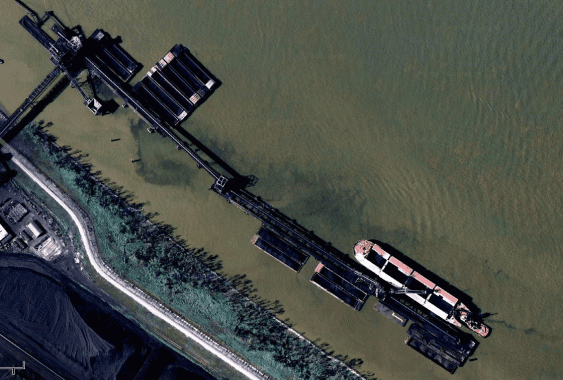Kinder Morgan has big coal export designs for the Columbia River. Before Northwest officials decide whether to give the go-ahead, the public should examine Kinder Morgan’s track record with coal elsewhere because it’s plain awful.
And it’s only getting worse.
Down south, Jonathan Henderson has collected a series of images of Kinder Morgan’s operations on the lower Mississippi where the firm stores huge coal piles by the river side with only puny containment systems. When Hurricane Isaac hit the region in late August, it overwhelmed Kinder Morgan’s bare-bones safety features sending coal cascading into local water bodies and blanketing the surrounding marshes with coal dust.
As Henderson points out in his commentary:
Coal is stored in large piles at terminals, and these piles are extremely susceptible to the elements such as wind and rain. Residents in Plaquemines communities like Ironton and Myrtle Grove complain that coal dust coats their homes, playgrounds, plants, cars and boats. Coal runoff has heavy metals, sulfides, and other toxics that impair the health existing marshes and degrades water quality. It also poses significant risks to human health… The direct discharge of coal dust into water bodies, which was apparent from the photographs you just saw, threatens the health of fish and other critters. Ultimately, the entire food chain is at risk.
If you care about the Columbia River, I encourage you to check out what Henderson has to say, and then go take a look at the pictures here and here.
It’s true that the lower Columbia, where Kinder Morgan wants to operate, is not exposed to hurricanes, but it’s also clear that the company does not adequately prepare for local weather conditions. What’s more, the Northwest is susceptible to occasional storms with extremely high wind velocity—among the fiercest anywhere in the country—and late autumn rains routinely result in serious river floods. There’s not much reason to think that Kinder Morgan would take better care of the Columbia than they do of the Mississippi:
Keep in mind that this photo—clearly showing coal dust spewing into the Mississippi—was taken on a calm day. Ugly as it is, this is an image of Kinder Morgan’s coal operations when things are going well.
Update 11/1/12 — Not that we needed more proof that Kinder Morgan is a bad actor, but now it turns out the company is “racking up fines” from the US Environmental Protection Agency and the Oregon Department of Environmental Quality for violations at a petroleum storage facility in Eugene. These fines for Kinder Morgan come on the heels of federal penalties for insufficient risk management at two natural gas processing plants in Wyoming.










Chris Troth
Eric,
You have talked before of the numbers of the mile+ long trains, off which coal dust would blow, disrupting our towns and cities and clogging the rail lines. Do you, or does anyone have an idea of how much of the coal would be piled up at the various ports, under the proposed export plans, and for how long at a time, waiting for ship transport?
It would be very interesting to have an idea of planned volumes in an appreciable context (how many Safeco fields, for example).
Also, I’m sure the coal co’s have very good estimates of how much volume they lose to wind and water erosion in transit. Are those numbers public? Or have third parties done the math?
Another great post – keep up the good work.
Eric de Place
Great question, Chris.
I don’t have an answer right off the top of my head, but I’ll do some digging and see if I can put together a blog post with a little social math to put it in context. Having visited two coal terminals — Westshore and Ridley, both in BC — I can vouch for the fact that the stockpiles are enormous and have a distinct Mordor-like appearance.
Eric de Place
Bellingham-based photographer Paul Anderson has some great photos of the Westshore coal terminal in BC here: https://picasaweb.google.com/101001542045438908684/CoalExportTerminals
Michael Riordan
Dear Eric,
The NW does indeed experience hurricane-force winds, as occurred in 1983 and 1989-90. Orcas Island, where I now live, suffered winds over 100 mph in December 1990, blowing down trees all over the island and knocking out power for weeks. These are called Fraser Gap Winds, which have been extensively researched by UW meteorology professor Cliff Mass. A similar phenomenon is the Columbia Gorge winds that would affect barges (and trains, for that matter) bringing coal down the Gorge.
I am researching these gap winds and trying to determine their likely effects on the storage piles at the proposed Gateway Terminal.
Best regards, Michael
elizabeth allen
Kinder Morgan has its site set on the Port of Wilmington, Delaware. Jack Markell Gov (d) and Alan Levin (r) his economic developement director have done a secret back door deal to sell or lease our port. this deal was done without any legislators knowledge without environmental impact studies, audits of port finances etc. Through good citizen work, we were able to get our legislators up to speed and this wk, the House voted unaninously to have oversight of the deal. However, we do not believe the administration will do its due diligence to our citizens. The long history of Kinder Morgans environmental track record leaves our citizens out in the cold. We are desperately seeking outside environmental groups to come and assist us. We have a 30 day window to stop this backdoor deal. The port is the largest cold storage port on the eastcoast. Several huge fruit companies do biz here, but if a Kinder comes in and brings its liquified gas, coal and coal ash, those fruit companies will not stay. Delaware has one of the highest cancer rates in the nation, with this vile company adding to the pollution our citizens are not safe. If you know any legal folks, that can help us, please have them contact: spktruthtopower200@yahoo.com. Thanks.